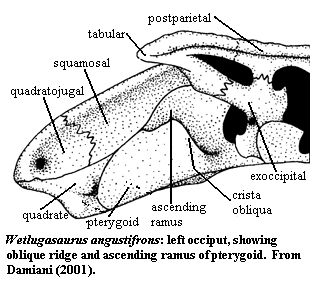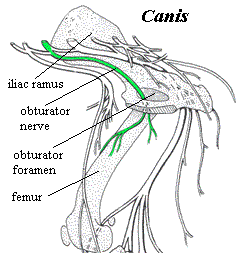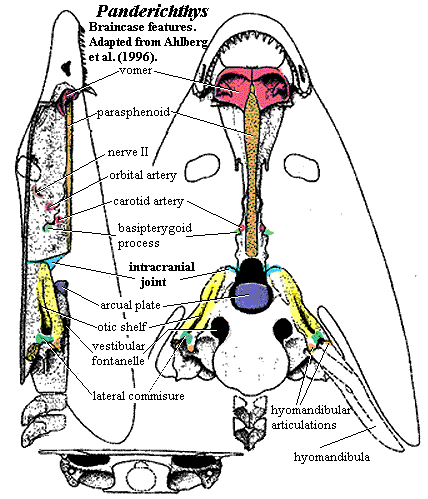| Glossary | ||
| The Vertebrates | O |
| Vertebrates Home | Vertebrate | Vertebrate | Bones | Time |
For most phrases beginning with directional words, e.g. "posterior," "dorsal," "external," etc., or some generic anatomical terms, e.g., "vena," look under the next word in the phrase. However, note that this convention is not used with complete consistency in this Glossary.

Oblique muscles the anterior pair of extrinsic eye muscles. See figure at rectus muscles; see also discussion and figures of the gnathostome orbit.
Oblique ridge (= crista obliqua) [1] in mammalian lower molars, (at a guess) a ridge that proceeds from the hypoconid, generally in the direction of the metaconid or the middle of the trigonid, i.e. diagonally across the tooth in a linguomesial direction. [2] of the pterygoid in basal tetrapods, a marked flange on the occipital exposure of the pterygoid presumably providing muscle attachments related to lateral movements of the head. See figure at right.
Obturator Foramen a depression or hole formed by the pubis and ischium. See figure at antitrochanter. Discovery of the ichthyosaur Ophthalmosaurus (Reptilia) in the Late Jurassic of the Boulonnais (ichthyosaur).

Obturator nerve The obturator nerve supplies the adductors of the thigh and contributes to the nerve supply to the skin of the medial side of the thigh. The obturator nerve follows the medial surface iliac shaft, before leaving the muscle dorsomedially, crossing over the ventrally lying common iliac vein into the obturator foramen. The nerve then branches into the adductor muscles of the thigh. In mammals, these include the gracillus, pectineus and adductor externus. All of these muscles are primarily adductors of the pelvic limb, and their motion is innovated by the obturator nerve. Source: image & most text from 4. The Obturator Nerve.
Obturator process a blade-like process extending from the ventral shaft of the ischium. See figure at antitrochanter.
Occipital condyle a rounded projection(s) from the back of the skull which meets the first cervical (neck) vertebra and allows the head to flex and/or rotate on the end of the spine. It is usually formed by some combination of the basioccipital and the exoccipitals. See The Occiput for details.
Occipital region (a) the most posterior region of the braincase. See The Braincase. (b) the bone surrounding the foramen magnum and bearing the occipital condyles. Formed from 4 embryonic elements, the basioccipital below, 2 exoccipitals, and the supraoccipital above. See The Occiput.
Occipital view looking towards the back of the skull.
Ocher Locality Tartarian Late Permian) of Russia, in the southern Urals. Known for basal therapsids and temnospondyls.
Oculomotor nerve Cranial nerve III, which controls the extrinsic eye muscles except for the superior oblique and lateral rectus. See figure at rectus muscles; see also discussion and figures of the gnathostome orbit.
Odontoblast a dentine-forming cell
Odontode the basic unit of teeth and scales, sometimes lengthened and thickened to form spines. Odontodes have an inner cavity of soft tissue, often containing blood vessels, covered by a cone of dentine and capped by hypermineralized tissue (e.g., enamel). According to some sources, spongy bone may also be involved. However, the attachment to underlying bone seems to be rather variable. This may be an anatomical term with slightly different meanings in different taxa.
Odontoid process [1] Apparently, same as the dens, i.e., a process of the axis (2nd cervical vertebra) which projects anteriorly into the atlas (1st cervical). Embryologically, this process results from fusion of the axis intercentrum and the atlas centrum in mammals, creating a rotary joint about which rotary movement occurs. In other tetrapods a variety of arrangements are possible, including the mammal-like arrangement. However, since the condyle is not doubled in these forms, the odontoid process does not have the same significance or necessarily have the same function. [2] a small process on the anterior surface of the atlantal (first cervical) centrum that fits into a cavity on the occipital condyle (in the back of the skull). Used in this sense at Phylogeny of Stegocephalians.
Oldman Formation may be part of Judith River Fm. Mid-Campanian of Alberta, Canada. Wilson et al. (1992). Esociformes. Id.
Olecranal fossa same as olecranon fossa.
Olecranon Gr. olenokranon, from olene = elbow, and kranos = helmet. In other words, the protector of the elbow. The pectoral limb analog of the knee cap (patella). Occurs as a proximal extension of the ulna, important as attachment for extensor muscles of the forelimb.
Olecranon fossa on the distal humerus, posterior (dorsal or anconal) face, in mammals and birds. A long groove beginning between the epicondyles and extending proximally up the humeral shaft. This groove accommodates the olecranon process of the ulna. See Humerus.
Oligo- Gr. root for few, several, somewhat
Omasum the third chamber of the ruminant digestive tract, the first of two chambers used for bacterial fermentation of cellulose. See Artiodactyla for figure.
Ontongeny development. Normally used of post-larval or post-fetal development to the final adult form.
Open-rooted of mammaliform dentition, ever-growing. This condition is marked by tooth roots which are "open," being very thin-walled with large pulp cavities. Such roots are typically quite long, since they would otherwise be too weak to fix the very active teeth of the herbivores which typically have this type of dentition.
Operculum L. operculum = lid, cover. Used of the dermal bone covering the gill slit in actinopterygian fish, the plate-like bone found on the fenestra ovalis of amphibians See The Ear.), etc.
Opistho- Greek root meaning either "behind" or "reversed," "opposite." In the latter sense it is synonymous with the prefix "enantio-."
Opisthocoelous a pattern of vertebral articulation in which the individual vertebrae are convex anteriorly and concave posteriorly. Opposite of procoelous. lab7 photos.
Opisthopubic"retroverted" pubes, i.e., a pelvic girdle with the pubic bones pointing back toward the tail.
Opisthotic The opisthotic is the posterior of the two bones making up the otic capsule and is usually fused to the prootic, the anterior otic bone. The opisthotic is an endochondral bone. It is usually the largest contributor to the paroccipital process and to the structures of the middle and inner ear. It normally contacts all of the occipital bones and the prootic, and may contact the basisphenoid. It often forms part of the edge of the foramen ovale, the door to the inner ear.
ops Greek root (normally suffix) for face or (less often) eye.
Optic nerve Cranial nerve II, which enervates the intrinsic eye muscles and the retina of the eye. See figure at rectus muscles; see also discussion and figures of the gnathostome orbit.
Oralobranchial relating to the normally medial duct or cavity which serves both for respiration and ingestion; the mouth or throat.
Orbitosphenoid Portion of the sphenoid that is visible in the wall of the orbit.
Orbito-occipital regionsee The Braincase
Orbitostylic a type of jaw suspension in which the upper jaw is attached to the braincase near the orbits, generally by a strong, but somewhat flexible soft tissue connection.
Ordovician The second period of the Paleozoic, c. 490-442 Mya.
Orecto- Gr. root (oρεκτo-) stretched out, thrust forward, or placed erect (to which it is closely related through the L. erigo, erectus). It has a secondary meaning as want, desire -- for reasons too obvious to discuss.
Organ of Corti The system of hair cells in the mammalian cochlea of the inner ear which sorts sound by frequency and transduces it into nerve impulses. See the Ear.
Orthal of jaw motion, up and down. This kind of motion is primitive for synapsids and is usually associated with simple carnivory. However, it can be adapted to shearing, as the cusps slide past each other, or even to grinding. As opposed to propalinal, using back & forth anteroposterior motion.
Os basale fused ossification in Gymnophiona, consisting of exoccipitals, parasphenoid & otic capsules.
Osawa Formation Early Triassic (Spathian) of Japan. Utatsusaurus.
Ossification the process of becoming bone
Osteoderm scute; dermal bone lying over the epidermis as armor or ornamentation.
Osteon structural unit of bone in advanced vertebrates, consisting of concentric rings of osteocytes in an apatite matrix around a central canal, through which pass nerves, blood and lymphatic vessels. Osteons are cross connected at intervals by lateral Volkmann's canals which allow lateral connections of circulatory vessels or nerves.
Osteosclerosis increased density of bone due to replacement of trabecular bone by compact bone.
Ostium L. ostium = door or opening.
Ostraciform a type of undulatory locomotion in which the body is inflexible and only the tail undulates.
Otic (a) of or pertaining to the ear. (b) the region of the braincase associated with the otic capsules. See, The Braincase. The otic region is dominated by the prootic. Other "bones" may include the epiotic, sphenotic, opisthotic and (in mammals) the petrosal. The otic capsule is typically setoff anterolaterally from the occiput by a fissure or gap, and may be bordered anteriorly by a ventral fissure separating it from the sphenoid region.
Otic articulation of the palatoquadrate. One of the possible dorsal articulations of the palatoquadrate in which the palatoquadrate articulates with a process on the otic capsule. See image at paratemporal articulation.
Otic capsule The bone structures containing the organs of the inner ear, principally the labyrinth and the maculae.

Otic shelf in sarcopterygians, the basioccipital divides on either side of the basicranial fenestra to form two shelves. The jugular vein runs along the top of these shelves toward the intracranial joint.
Otoccipital in sarcopterygians and basal tetrapods, relating to the posterior half of the divided braincase, containing the otic and occipital regions. The anterior half is referred to as the ethmosphenoid or sphenethmoid.
Otico-occipital same as otoccipital.
Otoconium same as otolith. See The Ear.
Otolith Gr. "ear-stone" (?). Minute calcium carbonate "stones" associated with neuromast organs in the labyrinth. The "stones" deform the villi of the hair cells in response to changes in orientation in the gravity field. See The Ear.
Otosphenoidal crest appears to be synonymous with the crista prootica. See Makovicky et al. (2003).
Outgroup In cladistics, a taxon, not a member of the group under study, which is used to fix the polarity of character states. Cladistics without an outgroup yields a shortest path between species, but does not say where the path begins -- where the root of the phylogenetic tree is. The outgroup comparison roots the tree. Typically, the outgroup is a taxon just basal to the group under study and is assumed to have all characters in the primitive state. In essence, the outgroup is used as a proxy for the last common ancestor of the group (assuming the group turns out to be monophyletic within the limits of the study). This assumption need not be completely accurate. However, the degree to which the outgroup differs from the hypothetical ancestor obviously introduces an error of essentially unknown size and requires some assumptions about the phylogeny of the outgroup itself. Example: Panderichthys in a study of early tetrapods.
Oval windowsee fenestra ovalis.
Ovate egg-shaped, i.e. an ellipse with one end larger than the other.
Ovoviviparous young are born from eggs, but the eggs are incubated internally.
Oxbow Low-energy rivers, as on coastal plains, will frequently change course, leaving long, arc-shaped lakes in the former riverbed. These lakes may persist for considerable periods. They are referred to as oxbows, based on the resemblance to the shape of the yoke traditionally used to harness oxen.
checked ATW030614